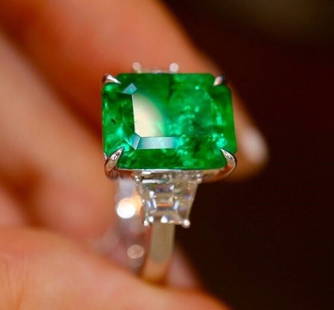
SEATED BODHISATTVA MAITREYA
Similar Sale History
View More Items in EarringsRelated Earrings
More Items in Earrings
View MoreRecommended Jewelry
View More







Item Details
Description
Ca. 300–400 AD. A seated figure of the Bodhisattva Maitreya, the Buddha who is believed to be incarnated in the future for the salvation of mankind. Carved from a fine grained grey chlorite-schist, the figure displays sensitive treatment of the carving, particularly in the details of the robes. The head is turned to the left and is crowned by an elaborate headdress composed of a turban with strings of jewels and a characteristic fan shaped piece gathered to the front. The face is expertly carved with a sensitive, slightly smiling mouth, heavy lidded eyes and a straight nose characteristic of Eastern Roman art, and a moustache more commonly associated with indian art. Between the eyes is an Urna, one of the symbols of a great being that depicts the third eye that enabled the Bodhisattva the ability to see past the mundane world of suffering. The ears are pierced and elongated from the heavy earrings commonly worn by aristocrats of India and Central Asia at the time. Behind the head is a large halo.The body is strongly proportioned and across the chest are three strands of necklaces, one running diagonally across the chest and strung with a series of amulet cases known as Kavacha. These amulets are still worn in India today, and they were popular in the Roman Empire, with examples depicted on the famous Faiyum mummy portraits from Egypt. The left hand rests on the knee, whist the right was originally held up to the face in the so-called “pensive” manner that is a characteristic of Maitreya images. The figure sits on a throne with lattice work panels, and on the seat is a large cushion. The right leg is slightly drawn up in the so-called “royal ease pose”. The throne in turn is supported by a lotus flower, with the petals rendered in exceptionally fine realism.Maitreya is believed to be the future Buddha, who currently resides in the Tushita heaven. As a Bodhisattva he has achieved enlightenment, but not entered Nirvana, instead choosing to help living creatures achieve enlightenment too. His name is derived from the Sanskrit word Maitri, meaning “friend” and this in turn may be derived from the Persian deity Mithras, also known as Mithra or Mitra, whose name also meant friend. Indeed, it is possible that the cult of Maitreya may have been influenced by the Persian deity as Central Asia and parts of India were ruled by the Persian Empire prior to its conquest by Alexander the Great. The pensive pose that Maitreya displays, represents him seated in the Tushita heaven contemplating the suffering of living beings, and waiting until the time when he can enter the world for its salvation. This future time is believed to be when the teachings of the Buddha have disappeared and mankind is living in extreme suffering. Maitreya will then be incarnated in the world to save all living beings.The treatment of the robes, jewellery and headdress show that he is represented as a noble of the time from Northern India and Central Asia, and it would have been members of the elite who would have dedicated these reliefs at monasteries and popular sites of pilgrimage. This would have been a meritorious act in the hope of a better rebirth. The practice of offering reliefs seems to have come from Greece and Rome, where it was one of the primary acts of devotion. The production of devotional images, such as this, probably began in the late second century AD. These images were produced for worship by both the laity and the monastic community, and their production coincides with a decline in the popularity of narrative panels, almost all of which illustrate the sacred biography of the Buddha. This shift has often been seen as marking a transition in Buddhist ideology from the earlier Hinayana school of teaching, which emphasized the veneration of relics, to later Mahayana practices centred on the veneration of images of Bodhisattvas and cosmic Buddhas.Compared to the art of peninsular India, Gandharan art can be described as more naturalistic, both in the rendering of the body and in the movement of the garments. The representations of the Buddha and Bodhisattvas were inspired by the representation of Hellenistic and Roman gods and aristocracy. One of the closest parallels of art from the time of the Roman Empire is that from Palmyra, which was a trading hub between India and the west. Here, the religious and funerary reliefs display close similarities in the rendering of the facial features and carving of the folds of the garments, and especially in the decorative elements, such as the jewellery, to those depicted on Gandharan pieces. This clearly demonstrates the close trading ties between the east and the west that resulted in the sharing of cultural motifs and styles. This was not something new however, as the grey chlorite-schist so popular for the creation of Gandharan sculpture, was employed millennia earlier in the production of vases and small sculpture from Mesopotamia, and which were exported across the Near East and the Indus Valley civilisations.The item was researched by Bret Gaunt. For a similar piece see The Art Gallery of New South Wales, Australia, accession number 7, 1997; Beguin, G. (2009). Buddhist Art. Bangkok: River Books, 212, fig. 23. For more information about Gandharan art, see Jongeward, D. (2019). Buddhist Art Of Gandhara in the Ashmolean Museum. Oxford: Oxford University Press. Provenance: From the collection of a London gentleman; formerly acquired in early 2000s in France; previously in 1970s European collection. Size: L:870mm / W:350mm ; 30k+g
Buyer's Premium
- 20% up to £100,000.00
- 20% above £100,000.00
SEATED BODHISATTVA MAITREYA
Estimate £10,000 - £20,000
14 bidders are watching this item.
Shipping & Pickup Options
Item located in London, London, ukOffers In-House Shipping
Local Pickup Available
Payment

TOP



































































